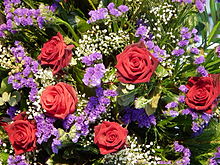Baby’s breath meanings: Festivity, innocence, pure of heart
 Gypsophila commonly known as baby's-breath in the United States and Canada, "soap wort" in the United Kingdom, elsewhere Gypsophila—is a genus of about 100 species of flowering plants in the family Caryophyllaceae, native to Europe, Asia and North Africa. Many species are found on calcium-rich soils, including gypsum, hence the name of the genus. Some species are also sometimes called "baby's breath" or simply, "Gyp", among the floral industry. Its botanical name means "lover of chalk", which is accurate in describing the type of soil in which this plant grows.
Gypsophila commonly known as baby's-breath in the United States and Canada, "soap wort" in the United Kingdom, elsewhere Gypsophila—is a genus of about 100 species of flowering plants in the family Caryophyllaceae, native to Europe, Asia and North Africa. Many species are found on calcium-rich soils, including gypsum, hence the name of the genus. Some species are also sometimes called "baby's breath" or simply, "Gyp", among the floral industry. Its botanical name means "lover of chalk", which is accurate in describing the type of soil in which this plant grows. Originally from Eastern Europe, its natural habitat is on the Steppes in dry, sandy and stony places, often on calcareous soils (gypsophila = "chalk-loving"). Specimens of this plant were first sent to Linnaeus from St Petersburg by the Swiss-Russian botanist Johann Amman. It is cultivated in Peru corresponding to a large portion of this country's flowers exports.
Originally from Eastern Europe, its natural habitat is on the Steppes in dry, sandy and stony places, often on calcareous soils (gypsophila = "chalk-loving"). Specimens of this plant were first sent to Linnaeus from St Petersburg by the Swiss-Russian botanist Johann Amman. It is cultivated in Peru corresponding to a large portion of this country's flowers exports. They are herbaceous annual and perennial plants growing to 5–120 cm tall. The leaves are opposite, linear to narrow triangular, often falcate (sickle-shaped), 1–7 cm long and 2–8 mm broad. The flowers are produced in large inflorescences, which may be either dense or open and lax; each flower is small, 3–10 mm diameter, with five white or pink petals.
 Gypsophilas are often grown as ornamental plants in gardens; they are grown both as garden plants and also valuable as a cut flower in floristry to add as a filler to flower bouquets. The most commonly encountered in gardens are G. paniculata (a perennial species), G. elegans, and G. muralis (both annual species). They are easily propagated from seed, by cuttings, or by root division before growth starts in the spring. Starting as a tiny seed, the annuals and perennials germinate in ten to fifteen days, and can grow rapidly up to 50 cm in height. While they prefer full sun, along with rich, light soil, deficiencies in poor soil constitution can be overcome by adding a general purpose fertilizer, as long as it is well drained.
Gypsophilas are often grown as ornamental plants in gardens; they are grown both as garden plants and also valuable as a cut flower in floristry to add as a filler to flower bouquets. The most commonly encountered in gardens are G. paniculata (a perennial species), G. elegans, and G. muralis (both annual species). They are easily propagated from seed, by cuttings, or by root division before growth starts in the spring. Starting as a tiny seed, the annuals and perennials germinate in ten to fifteen days, and can grow rapidly up to 50 cm in height. While they prefer full sun, along with rich, light soil, deficiencies in poor soil constitution can be overcome by adding a general purpose fertilizer, as long as it is well drained. Gypsophila paniculata is now widely distributed in North America. It is classed as an invasive species in places around the Great Lakes, such as the Sleeping Bear Dunes National Lakeshore and the Chicago region, and in the Pacific Northwest.
Gypsophila paniculata is now widely distributed in North America. It is classed as an invasive species in places around the Great Lakes, such as the Sleeping Bear Dunes National Lakeshore and the Chicago region, and in the Pacific Northwest. In the United States, it is common for young girls, particularly children attending weddings, to have their hair decorated with Baby's Breath.
Gypsophila paniculata has become an invasive species in parts of North America.
Gypsophila rokejeka is used to provide saponins in the production of halva.
 Gypsophila species are used as food plants by the larvae of some Lepidoptera species including three case-bearers of the genus Coleophora which feed on G. fastigiata: C. kyffhusana, C. niveistrigella (both of which feed exclusively on the plant) and C. vicinella.
Gypsophila species are used as food plants by the larvae of some Lepidoptera species including three case-bearers of the genus Coleophora which feed on G. fastigiata: C. kyffhusana, C. niveistrigella (both of which feed exclusively on the plant) and C. vicinella.The root of the Gypsophila repens is used to make the whip cream topping of the Turkish dessert kerebic. Boiling the root over a period of hours produces white bubbles which are collected, mixed with sugar, and mixed until it thickens to a cream.
Source, Images: http://en.wikipedia.org/wiki/Gypsophila










0 comments:
Post a Comment